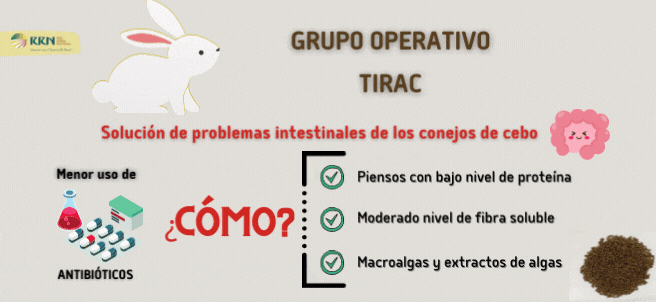
01 de June de 2022
Innovación
Current management of rabbits for meat production requires professionals to use antibiotics to ensure their health. The TIRAC Operational Group is working to improve the treatment of digestive problems in fattening rabbits.
The TIRAC Operational Group is working to ensure the health of fattening rabbits by reducing the use of antibiotics.
- The Task Force seeks to reduce or eliminate antibiotic use in rabbits intended for meat to maintain their health and profitability.
- If successful, the project could improve meat quality and improve consumer health, while maintaining the profitability of the farmer.
Current livestock management of rabbits for meat production requires professionals to use antibiotics to ensure their health.
With the aim of eliminating or reducing the use of these drugs, the TIRAC Operational Group (GO TIRAC) began operating last year in Galicia, Madrid, and Navarre to improve the treatment of digestive problems in fattening rabbits. They claim that reducing antibiotic use is the main challenge facing the rabbit industry, "and the lack of solutions is very likely to lead to the failure of the sector."
GO Solutions
To reduce or eliminate the need for these medications, the TIRAC Operational Group has implemented a series of nutritional strategies in the feeding of these animals that will improve their intestinal health :
- Creation of low-protein feed
- With moderate level of soluble fiber
- Incorporation of macroalgae and/or seaweed extracts, taking advantage of discards, inputs, waste and/or species of marine algae with nutritional value
Secondarily, solving this problem could facilitate the achievement of two other objectives: obtaining better quality meat and increasing the value of the algae production sector, if the algae can ultimately be incorporated into animal feed formulations.
Project phases
The project consists of 5 activities or phases that are being carried out in this order:
- Survey of livestock farmers: A survey conducted in the sector in early 2021 to understand the real issues surrounding health and antibiotic use on rabbit farms.
- Evaluation and utilization: On-farm and farm trials have been conducted since June 2021 to test, among other things, the digestive effectiveness of certain types of fiber.
- Identification of the algae/byproduct/extract with the greatest effect on intestinal health in the rabbit after weaning.
- Evaluation of the best nutritional strategy for intestinal health, avoiding the use of antibiotics in bait.
- Dissemination and transfer of results: with the project closing in the first quarter of 2023.
According to Eugenio Cegarra, technical director of regulatory affairs at De Heus , the nutrition company piloting GO TIRAC, who spoke to the National Rural Network (RRN) , the project is in its second phase.
“We've conducted four trials,” he explains. “We're currently collecting data, and the results aren't yet conclusive. However, with the treatments already applied, we've been able to rule out some nutritional uses, such as insoluble fiber. We can also confirm that antimicrobial treatment reduces mortality.”
According to Cegarra, the Spanish rabbit sector is one of the strongest in the world and is "positioning itself at the forefront." Therefore, the work of the GO can "be very useful" and generate new advantages that can be used by any livestock farmer worldwide.
Components and financing
The Operational Group is made up of 5 applicant members ( De Heus Animal Nutrition SA , Galician Business-University Foundation ( FEUGA ), which represents the GO; Porto-Muiños SL , the University of Santiago de Compostela ( USC ), the Polytechnic University of Madrid ( UPM ), Naraba Rabbit Breeders Cooperative Society , the Association of Rabbit Producers of Galicia (PROGACUN) and Granja J. Echegoyen SL ).
The project has a budget of €492,580.38, with a total grant of €485,043.58. It is 80% co-financed by the European Union's European Agricultural Fund for Rural Development (EAFRD) and 20% by the Ministry of Agriculture, Fisheries and Food, as part of the 2014-2020 National Rural Development Program.









